Arrow bullets: the path of false hopes or a history of lost opportunities? Part of 2
Among the experimental work of the recent past, one of the most promising and promising projects was the development of cartridges with feathered sub-caliber bullets for rifle bullets. weaponsthat have been going on for a long time both here and abroad. But cartridges with OPP (feathered sub-caliber bullets) have not been put into service either here or abroad. So what was it, why didn’t it take off? This article focuses on the subject and stories of these developments and is largely based on data from the monograph "Small arms ammunition" Vladislav Nikolaevich Dvoryaninov.
The success of any development is ultimately evaluated only by the results achieved. For small arms - the effectiveness of fire, the evaluation of which is consistently composed of three main factors: 1) to hit the target, 2) to break through the defense of the target, 3) to hit the target. And in the specified sequence. Professionals are well aware that taking separately, even such important indicators as scattering when firing single shots or the penetration effect of a bullet are NOT direct indicators of efficiency, but only one of the common set of all factors that have an impact on the final result. Paraphrasing the classics, we can say that “efficiency issues are the most difficult issues in the world” ...
The organization of firing on efficiency is a rather troublesome event, since to obtain reliable results it requires professionalism, a large amount of testing and material support, including the availability of streamlined weapons and an appropriate number of cartridges with stable characteristics. For shooting by experienced cartridges in Izhevsk on the basis of the SVD and PC, smooth-bore SVDG sniper rifle and a PKG machine gun, shown in the figure, were developed. It is interesting that there were no special requirements for weapons to increase the effectiveness of shooting. On the contrary, experienced smooth-bore machine gun and rifle should correspond as much as possible to their staff counterparts in order to objectively assess the impact of the new cartridge. For the same reason, the question of the case of the new patron of the “modern form” was not raised without a protruding lip.
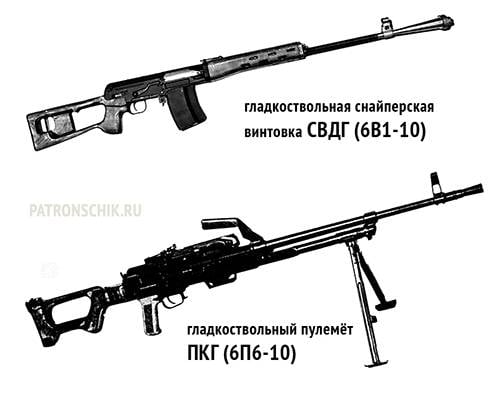
On the ground tests for evaluating the effectiveness of shooting in 1973, the first and simply fantastic results were obtained for the sub-caliber: “An experienced machine-gun complex, thanks to the best flatness of shooting, significantly surpassed the regular complex - when shooting single shots - by 1,6 and 8,7 times, in particular, by hitting the target. When shooting bursts from the machine - from 2,47 to 12,6 - 21,3 times for the frequency of hitting the target". The shooting was carried out at a distance of 700, 900 and 1000 meters, at targets No. 8 and No. 11 ... And this is despite the fact that at that time the smooth-bore machine gun was inferior to the standard machine gun in accuracy of combat using experienced cartridges in the area of dispersion, on average, twice. However, only the results of firing by single shots were recognized as fairly reliable due to the limited amount of testing in firing by bursts, which is quite correct.
At the preliminary tests in the fourth quarter of 1980 g (at the TsNIITOCHMASH test site, before the extended field tests) similar results were obtained. At the same time, the volume of firing also did not give an opportunity to call these results completely reliable. But the main, most positive fact was not the multiplicity of superiority, but the actual and significant increase in the frequency of hits. Therefore, the developers with rather reasonable enthusiasm expected the results of extended field tests at the Rzhevsky testing ground, which were planned for the 1981 year. And the main, the main purpose of which was to conduct comparative firing at effectiveness.
But domestic studies on machine gun and rifle cartridges with a feathered subcaliber bullet were finally discontinued in the 1983 year, not least on the basis of the results of these tests. So what happened? Why "suddenly" was the work that was promising and lasted for such a long time and took away a lot of effort and was closed?
If today we evaluate the main reasons for such a decision, then it becomes clear that the fate of the project was predetermined before the tests, by the sum of several processes within the GRAU, 4 GU MOP and enterprises in the industry that took place in those years. Here are the main ones:
At first, the development of cartridges with feathered sub-caliber bullets by Western experts did not lead to anything, nothing like that was adopted and was not planned. And the main reasons for the failures there were called problems with lethal action and accuracy. But the main thing - there was no one to catch up this time.
SecondlyIt is worth remembering that the 1980 - 1983 years were the peak in the USSR, the heyday of the "period of stagnation." The management of Glavka and the enterprises of the cartridge industry rejected the degree and volume of innovations that would have to be implemented in order to master the mass production of new cartridges. The motivation for innovation, as they would say today, was close to absolute zero.
Thirdly, domestic patrons are to blame themselves ... Petr Fedorovich Sazonov, a very competent and experienced designer, who for many years was deputy chief engineer of TsNIITOCHMASH and head of the institute’s entire cartridge direction, in 1975, offered the option of an 6-mm caliber rifle cartridge, his calculations met the requirements for a promising machine-gun complex, primarily for ABS. This domestic project is now called the “six”, or “6х49 rifle”, although initially the length of the sleeve was 54 mm. By 1981, the Six has gained a sufficient number of supporters in the GRAU, in the High Command and in the leadership of TsNIITOCHMASH, especially considering the first two reasons given above. Typical and proven in the industry manufacturing technology of all elements of the cartridge, the classic design. Yes, it is inferior to the swept in all parameters, but it must fulfill promising requirements. It seems to be a completely convenient compromise.
All authors and ideologists of a cardinal change in the direction of work on the new machine-gun complex were absolutely sure that the “six” could be quickly brought to mind and put into service. Therefore, the bid was made specifically for this project. And that is why, in the conclusion of the Rzhev landfill, the 1981 test report of the year said: “Given the futility of many years of efforts to provide any acceptable technical characteristics of swept-arrowed bullets, with sufficient damaging effect of the latter, work on the possibility of creating a rifle cartridge with a swept bullet it is advisable to stop. With the substantiation in the report itself of another main claim - the unacceptable danger of the expansion of the sectors of the pallets for their troops.
As so, the attentive reader will ask, where did the accuracy of those two “sniper” games go (OP 02-81-61 and OP 03-81-61) why “suddenly” the opinion about the danger of scattering the sectors of pallets changed, and that showed comparative firing at effectiveness? The answers are surprising and, unfortunately, very simple: They did not consider it necessary to indicate in the report and in the final results the data of the shooting “sniper”. Effectiveness firing, which was the main target of the tests, was not carried out at all. A detailed "analysis" of the content of this report, especially considering the past 36 years, is of little interest, but some key points require comment.
Experienced cartridges with OPP showed practically the same dispersion when shooting from military weapons, were put to the landfill in the required quantity and nothing prevented the performance of comparative firing at effectiveness, even formally.
The striking and stopping effect of arrow-shaped bullets was higher or equivalent to the standard cartridges with the LPS bullet. And the wording of the conclusion did not correspond to the data of the report itself.
Speaking about the absence of "any acceptable characteristics of technical dispersion of arrow-shaped bullets," the test site was referring to the accuracy of shooting single shots compared to the standard sniper cartridge 7НХNUMX. But calculations of the probabilities of hits when firing ammunition with OPP from a sniper rifle showed that with a accuracy similar to the standard LPS cartridges, at least equal efficiency at short distances (to 1 m) and superiority at greater shooting distances is ensured. A refinement of the experienced cartridge to the level of accuracy of the sniper cartridge 300Н7 additionally increases the likelihood of getting only on 1 - 9% due to the dominant influence of the best flatness of the trajectory.
In addition, tests conducted at the beginning of 60-s of RP-46, SGM and PC machine guns using regular ammunition (LPS) as compared to the target sport cartridges “Extra” showed that more than 10 times smaller area of scattering with single sports shots ammunition does not lead to a practically noticeable increase in the effectiveness of firing with machine gun bursts. Which depends, first of all, on the design of the weapon and the magnitude of the recoil energy.
Determination of the actual area of the pallets on tests 1981, held "with fiction" - the machine gun was made 600 shots in long lines, from the machine, with an angle of elevation 30 degrees. The zone of spreading was determined by the extreme places of detection of fired pallets on the ground (fresh snow), without taking into account bounce. The resulting zone diagram is shown in the following figure to the left. Which does not coincide with the zone of expansion of the same in weight and initial speed of the sectors of pallets, given in the official report 1973 of the same Rzhevsky test site and shown in the figure to the right.
Regions in red in the diagrams denote a zone “dangerous by the effect of the sectors of the pallets on personnel”. The blue sector in the right figure indicates the zone in which 70% of all the shot pallets were detected. In both cases, the same range of the danger zone was obtained - 30 meters from the muzzle, beyond which the sector is safe. At the same time, in the 1981 year, the zone within which the sector of the pallet was considered “slaughter as a fragment” was not identified and highlighted. And then, continuing to lose his speed and energy very intensively, his danger decreased from being able to penetrate uniforms to the ability to inflict a cut or bruise on unprotected skin. This zone, according to the 1973 report of the year, is shown in hatching in the right figure and is limited to removing 14 from the muzzle. The principal difference is shown in the diagrams of the angles of departure - 56 and 22 degrees, which characterizes the magnitude of the lateral departure of sectors from the line of fire and is the main factor determining the probability of finding his fighter in the danger zone. There is also data from the 1978 TsNIITOCHMASH of the SVDG sniper rifle with the installation of vertical screens at different distances perpendicular to the direction of shooting and with the measurement of the maximum lateral deviation from the line of firing holes from the sectors. Their values are shown in red on the right in the figure for 14 and 30 meters. These values are indicative and important because they are more correct than the method of finding the shooting sectors on the ground, and also because there is no fundamental difference in the separation of sectors when firing a machine gun and a rifle. Thus, the initial conclusion about the security of the expansion of sectors for its troops should be considered more reasonable.
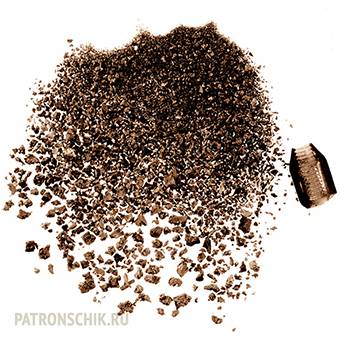
Moreover, understanding the undesirability of the expansion of sectors when firing from a machine gun and a sniper rifle, not worse than others, muzzle nozzles for crushing plastic pallets were developed and tested. One of the variants of which is clearly visible in the photograph of the SVDG given earlier. The result of the "work" nozzle is shown in the photo on the left. As shown by comparative shooting, such nozzles did not affect the accuracy of shooting, but their weight, dimensions and survivability were still unsatisfactory, so research in this direction could and should be continued.
But the decision was made and domestic studies on machine-rifle cartridges with a feathered subsaliber bullet were finally terminated in the 1983 year. How can we evaluate this decision and the results of work today?
On the one hand, the transition to the OCD stage was really not ready - the high-performance equipment and technologies for manufacturing all the elements of the cartridge were not sufficiently developed. It was necessary to refine the technology of molding the plastic sectors of the pallet and stabilize their characteristics. The complexity of the manufacture of an experienced cartridge with OPP in 1,8 times the complexity of the manufacture of a regular 7,62-mm rifle cartridge. It was necessary to refine the ordinary and tracer bullets for accuracy of shooting single shots. In other words, it took time, perseverance, and ingenuity to successfully complete the work.
On the other hand, to a large extent all the “natural problems” of the sub-caliber scheme were solved: the required level of accuracy of shooting was almost achieved; equivalent striking and greater stopping effect of 4,5-mm arrow-shaped bullets was achieved; the superiority in penetration action of high-strength barriers and in penetrating action of bullets was ensured. Resource smooth-bore machine-gun barrels exceeded 32 thousand shots.
The “natural advantages” of the subcaliber scheme were also confirmed: high ballistic characteristics were achieved, providing in the dimensions of the standard rifle cartridge DPV (0,5 m) = 615 m, with a smaller cartridge weight on 15% and a smaller recoil impulse. Provided superiority in probabilities of hitting the target, increasing with increasing firing range.
But, as already noted, the success of any development in small arms is ultimately evaluated (more precisely, should be evaluated) only by the result achieved - the firing efficiency. Therefore, not having these figures, obtained with a sufficient volume for shooting accuracy, any statement - both about the huge superiority of cartridges with OPP over the standard ones, and about the reverse - are not correct. Therefore, in any case, the decision to close the domestic project on cartridges with OPP was premature. Having spent considerable time on research, time and effort, it was necessary, at a minimum, to properly carry out all the necessary tests ...
The further development of the “six” was entrusted to the author of the arrow-shaped works - V.N. To the nobleman. In his own words, this work unexpectedly and truly fascinated him as a design engineer, evoking professional interest and a desire to understand the causes of previous failures of the “six” ... A new bullet, sleeve, capsule and powder charge were developed. Suddenly, for all the new cartridge has presented many surprises and problems that had not previously encountered. But almost all of them managed to solve at the expense of the original design and technological solutions. The work was brought to the stage of protection of a technical project, after which, at the end of the ROC, the adoption of the product is usually followed ... “Six” was closed in 1991, “just” without concluding an agreement for the final part of the ROC. Many believe that this was caused by the collapse of the USSR. Which, of course, influenced. But the main reason was another change of priorities among customers and the promotion of new favorites in the military science environment with the “correct” requirements for cartridges, in fact, uncompromising adherents of 7.62 caliber, reasoning by analogy with the well-known rule that “a car can be any color if he's black". But that's another story.
In the national history of working out cartridges with OPP, there was another, perhaps the most undervalued by customers, both then and today. At the initiative of the cartridge manufacturers, at the same time as the main 10 / 4,5-mm variant was tested, research was carried out on multi-cartridge cartridges. Moreover, returning to the “golden dream” of a single cartridge for a machine gun and machine gun, a single-cartridge 10 / 3,5-mm cartridge with a high initial velocity (1360 m / s) and a recoil momentum 0,87 kgf · s was developed. And the second version of the cartridge is a three-blade with 2,5-mm arrows. DPV (0,5 m) = 650 and 555 meters, respectively. Shooting from a machine gun and a machine gun could be conducted by any of them, with the conjugation of the trajectories, at least within the limits of ABS. With this solution, an increase in the effectiveness of firing for the machine gun is achieved not by reducing the recoil pulse and, consequently, less dispersion during automatic firing from unstable positions, but at all firing positions due to the volley fire effect. And, in addition to this, due to a significant increase in rejection and other advantages of sub-caliber bullets with a high initial velocity. It is precisely the absence of such a “supplement” in multipulse cartridges of a caliber scheme that did not make it possible to achieve acceptable bullet energies at medium and long ranges, and all attempts to create them in small calibers were considered unsuccessful. In any case, even a “just multi-gun” version of a machine gun and rifle cartridge would be extremely interesting and deserved close attention. The following photo shows all the main domestic patrons figurative of previous and current discussions about the ideal cartridge.
The table shows the main technical and ballistic data of these cartridges, according to their order in the photo. Analyzing and comparing these data, it is necessary to remember that in practice, not only the total energy of the bullet at the target plays an important role, but also the specific energy corresponding to the weight and cross-sectional area of each bullet. And when evaluating the breakdown action for classic bullets, the specific energy of the core itself must be considered. For example, the 10 / 3,5-mm cartridge data does not look as aggressive as a regular rifle cartridge. But the recalculation for specific energy gives a different picture. In addition, today, the requirement for a machine gun cartridge to break through a helmet or fragmentation vest at distances up to 1500 meters is very controversial, given the characteristics of typical targets for their area that had changed from 30-s of the last century and, accordingly, real probabilities of hit. For the “six” (the third cartridge on the left), the table shows the data achieved by the 1981 year, so that you can objectively evaluate “what was chosen from” at that time period. The third to the right shows the mockup of the three-hole version of the single cartridge. The following figure shows the graph of the change in the probability of bursts into the target number 10 "machine gun" when firing from PKM (from the machine, with a mechanical sight) with standard 7,62-mm rifle cartridge and 10 / 2,5-mm three-cartridge cartridges (V0 = 1200 m / s) for different target cores of dispersion CB x SAT on 100 m.
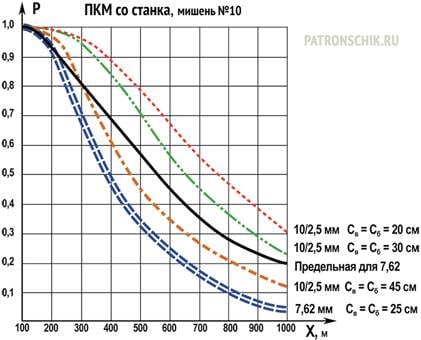
The “Limit for 7,62” line of graphics is an ideal variant, taking into account only the dispersion parameters and the mid-range aiming errors, and all other shooting errors are assumed to be zero. The lower curve corresponds to the calculated values when all the shooting errors are already taken into account. Calculations for multipulse were also carried out taking into account all shooting errors. The difference in values between the two curves for the standard cartridge clearly demonstrates the total effect of errors on the final result. And here in the calculations used data for the "best gunners." The probabilities of hitting “medium machine-gunners” at distances over 700-800 meters, to put it mildly, are even smaller. As can be seen from the graphs, the superiority of the multipulse cartridge of the sub-caliber scheme in terms of the probabilities of hits is very significant and allows you to exceed even the maximum possible values for single-cartridge cartridges. Against this background, almost all the "new" ideas look like children's games in the sandbox ...
The 10 / 4,5-mm rifle cartridge with a sub-caliber bullet, according to the available data, should exceed the “six” to a greater extent than the “six” exceeds the standard rifle cartridge. But the cost of rearmament is huge in both cases. And to decide whether the achieved advantage is sufficient is not easy. For cartridges with sub-caliber bullets, this question is still open. For the "six" more likely the answer is "no, not enough", including taking into account the modernization of the staff cartridge that was successfully carried out in subsequent years.
In conclusion, briefly referring to the discussions on the ways of the further development of modern small-arms rounds, we have to largely agree with the opinion of those experts who say that the possibilities of modernizing the classic-rounds cartridges have now been exhausted. The modernization allowed to significantly increase the range of penetration of high-strength and combined obstacles, including modern body armor. But did not fundamentally affect the probability of hitting the target. It should also be noted that almost any popular idea that is considered promising is still built around the classical, caliber cartridge scheme, therefore remaining within the appropriate ballistic framework and limitations. As a result, it is impossible to obtain a fundamentally new level of efficiency on this path.
Answering the main question of this article, formulated in its title, we can say that the development of domestic cartridges with feathered sub-caliber bullets is, unfortunately, a history of missed opportunities. Sub-caliber scheme, which can combine many modern developments, still remains very attractive with its “natural advantages”. But the final bringing it to mind in all respects is a rather complicated design and technological task. Nevertheless, it is very likely that there will be no other way out for a real increase in the effectiveness of small arms in the future.
In preparing this article the following materials were used:
"Modern Foreign Cartridges", Book-2 monographs "Small arms combat cartridges". V.N. Noblemen. D'Solo Publishing House, Klimovsk, 2015;
"Modern domestic cartridges, chronicles of designers", Book-4 monographs "Small arms combat cartridges". V.N. Noblemen. D'Solo Publishing House, Klimovsk, 2015
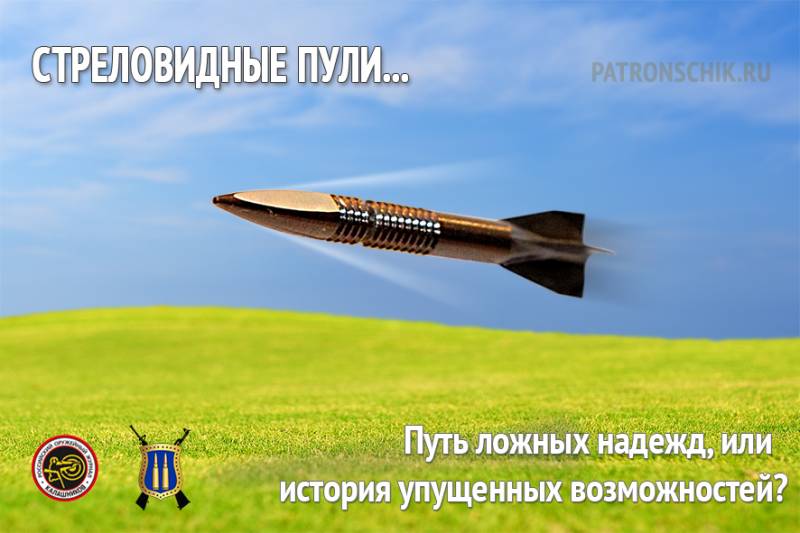
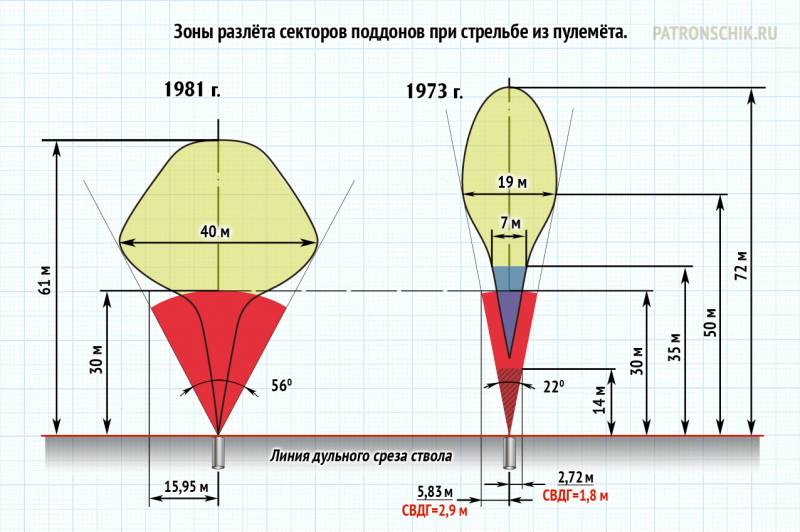
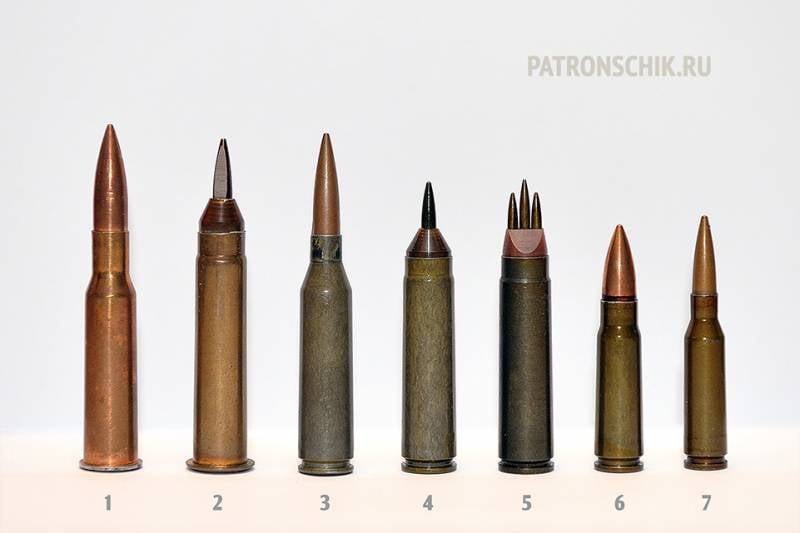
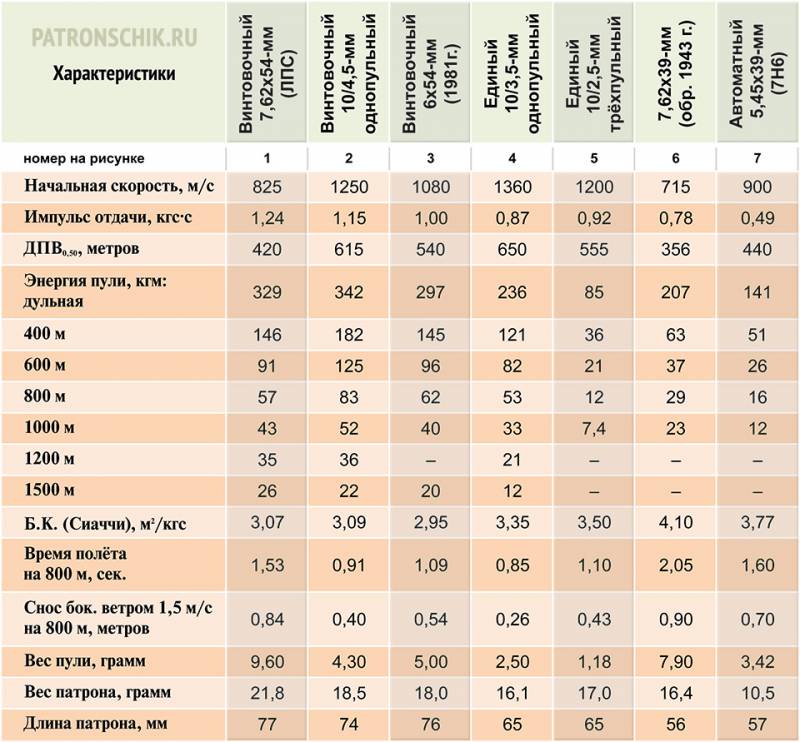
Information